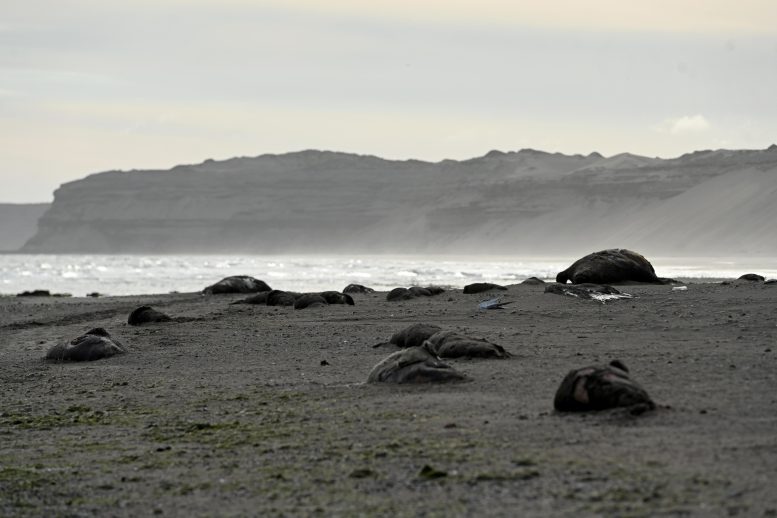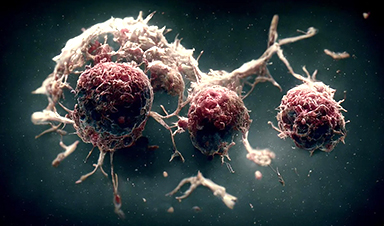A study from the University of California, Davis, and the National Institute of Agricultural Technology (INTA) in Argentina reveals that the highly contagious H5N1 avian influenza virus has evolved to transmit among birds and marine mammals, presenting a direct risk to wildlife conservation efforts.
The study, published in the journal Emerging Infectious Diseases, is the first genomic characterization of H5N1 in marine wildlife on the Atlantic shore of South America.
For the study, scientists collected brain samples from four sea lions, one fur seal, and a tern found dead at the most affected sea lion rookery in Argentina. All tested positive for H5N1.
Genome sequencing revealed that the virus was nearly identical in each of the samples. The samples shared the same mammal adaptation mutations that were previously detected in a few sea lions in Peru and Chile, and in a human case in Chile. Of note, the scientists found all these mutations also in the tern, the first such finding.
Elephant seals lie dead on a beach in Argentina following an outbreak of avian influenza in the region in 2023. Credit: Maxi Jonas
"This confirms that while the virus may have adapted to marine mammals, it still has the ability to infect birds," said first author Agustina Rimondi, a virologist from INTA. "It is a multi-species outbreak."
We know this because the virus sequence in the tern retained all mammal-adaptation mutations. Such mutations suggest a potential for transmission between marine mammals.
"This virus is still a relatively low risk for humans," said senior author Marcela Uhart, a wildlife veterinarian with the UC Davis School of Veterinary Medicine's One Health Institute and director of its Latin America Program within the Karen C. Drayer Wildlife Health Institute. "As long as the virus continues to replicate in mammals, it may make it a higher concern for humans. That's why it's so important to conduct surveillance and provide early warning."
The journey of H5N1
Uhart calls clade 2.3.4.4b — the current variant of H5N1 – "this new monster." It emerged in 2020, while the human world was reeling from a different pandemic, COVID-19. Avian influenza began killing tens of thousands of sea birds in Europe before moving to South Africa. In 2022, it entered the U.S. and Canada, threatening poultry and wild birds. It migrated to Peru and Chile in late 2022.
Then, almost exactly a year ago, in February 2023, highly pathogenic avian influenza entered Argentina for the first time. But it was not until August 2023 — when the virus was first found in sea lions at the tip of South America on the Atlantic coastline of Tierra del Fuego — that the virus unleashed its fatal potential in the region. From there, it moved swiftly northward, with deadly results, first for marine mammals and later for seabirds.
A recent paper Uhart co-authored showed a large outbreak killed 70% of elephant seal pups born in the 2023 breeding season. Mortality rates reached at least 96% by early November 2023 in the surveyed areas of Península Valdés in Argentina.
"When it first came to Argentina, we didn't know if it would affect elephant seals," Uhart said. "We never imagined the magnitude of what was to come."
Since 2022, H5N1 in South America has killed at least 600,000 wild birds and 50,000 mammals, including elephant seals and sea lions in Argentina, Chile, and Peru, and thousands of albatrosses in the Malvinas/Falkland Islands.
Moving south
The virus is now heading southward from South America, and scientists are deeply concerned about its potential impact on penguins and other wildlife in Antarctica.
Uhart and Ralph Vanstreels, her colleagues at UC Davis' Latin America Program in the School of Veterinary Medicine, are conducting wildlife surveillance for H5N1 in Antarctica this month.
"We need to keep an eye on the ability of this virus to reach species that have never been exposed to an H5N1 infection before," Rimondi said. "The consequences in those species can be very severe."
The concept of One Health honors the interconnectivity among humans, domestic animals, wildlife, and the environment. Interspecies disease outbreaks are unsettling examples of such connections and require global collaboration among public, wildlife, agricultural, health, and other sectors.
"We are trying to be at the forefront of documenting, recording, and providing early warning," Uhart said. "We've been in this area for 30 years. We know these species. We work with scientists who have 30 years of data on these populations, so we can know what will be important for the future. We have to give voice to these poor creatures. Nobody's taking note of how big this is."
Reference: "Highly Pathogenic Avian Influenza A(H5N1) Viruses from Multispecies Outbreak, Argentina, August 2023" by Agustina Rimondi, Ralph E.T. Vanstreels, Valeria Olivera, Agustina Donini, Martina Miqueo Lauriente and Marcela M. Uhart, April 2024, Emerging Infectious Diseases.
DOI: 10.3201/eid3004.231725
News
Scientists Melt Cancer’s Hidden “Power Hubs” and Stop Tumor Growth
Researchers discovered that in a rare kidney cancer, RNA builds droplet-like hubs that act as growth control centers inside tumor cells. By engineering a molecular switch to dissolve these hubs, they were able to halt cancer [...]
Platelet-inspired nanoparticles could improve treatment of inflammatory diseases
Scientists have developed platelet-inspired nanoparticles that deliver anti-inflammatory drugs directly to brain-computer interface implants, doubling their effectiveness. Scientists have found a way to improve the performance of brain-computer interface (BCI) electrodes by delivering anti-inflammatory drugs directly [...]
After 150 years, a new chapter in cancer therapy is finally beginning
For decades, researchers have been looking for ways to destroy cancer cells in a targeted manner without further weakening the body. But for many patients whose immune system is severely impaired by chemotherapy or radiation, [...]
Older chemical libraries show promise for fighting resistant strains of COVID-19 virus
SARS‑CoV‑2, the virus that causes COVID-19, continues to mutate, with some newer strains becoming less responsive to current antiviral treatments like Paxlovid. Now, University of California San Diego scientists and an international team of [...]
Lower doses of immunotherapy for skin cancer give better results, study suggests
According to a new study, lower doses of approved immunotherapy for malignant melanoma can give better results against tumors, while reducing side effects. This is reported by researchers at Karolinska Institutet in the Journal of the National [...]
Researchers highlight five pathways through which microplastics can harm the brain
Microplastics could be fueling neurodegenerative diseases like Alzheimer's and Parkinson's, with a new study highlighting five ways microplastics can trigger inflammation and damage in the brain. More than 57 million people live with dementia, [...]
Tiny Metal Nanodots Obliterate Cancer Cells While Largely Sparing Healthy Tissue
Scientists have developed tiny metal-oxide particles that push cancer cells past their stress limits while sparing healthy tissue. An international team led by RMIT University has developed tiny particles called nanodots, crafted from a metallic compound, [...]
Gold Nanoclusters Could Supercharge Quantum Computers
Researchers found that gold “super atoms” can behave like the atoms in top-tier quantum systems—only far easier to scale. These tiny clusters can be customized at the molecular level, offering a powerful, tunable foundation [...]
A single shot of HPV vaccine may be enough to fight cervical cancer, study finds
WASHINGTON -- A single HPV vaccination appears just as effective as two doses at preventing the viral infection that causes cervical cancer, researchers reported Wednesday. HPV, or human papillomavirus, is very common and spread [...]
New technique overcomes technological barrier in 3D brain imaging
Scientists at the Swiss Light Source SLS have succeeded in mapping a piece of brain tissue in 3D at unprecedented resolution using X-rays, non-destructively. The breakthrough overcomes a long-standing technological barrier that had limited [...]
Scientists Uncover Hidden Blood Pattern in Long COVID
Researchers found persistent microclot and NET structures in Long COVID blood that may explain long-lasting symptoms. Researchers examining Long COVID have identified a structural connection between circulating microclots and neutrophil extracellular traps (NETs). The [...]
This Cellular Trick Helps Cancer Spread, but Could Also Stop It
Groups of normal cbiells can sense far into their surroundings, helping explain cancer cell migration. Understanding this ability could lead to new ways to limit tumor spread. The tale of the princess and the [...]
New mRNA therapy targets drug-resistant pneumonia
Bacteria that multiply on surfaces are a major headache in health care when they gain a foothold on, for example, implants or in catheters. Researchers at Chalmers University of Technology in Sweden have found [...]
Current Heart Health Guidelines Are Failing To Catch a Deadly Genetic Killer
New research reveals that standard screening misses most people with a common inherited cholesterol disorder. A Mayo Clinic study reports that current genetic screening guidelines overlook most people who have familial hypercholesterolemia, an inherited disorder that [...]
Scientists Identify the Evolutionary “Purpose” of Consciousness
Summary: Researchers at Ruhr University Bochum explore why consciousness evolved and why different species developed it in distinct ways. By comparing humans with birds, they show that complex awareness may arise through different neural architectures yet [...]
Novel mRNA therapy curbs antibiotic-resistant infections in preclinical lung models
Researchers at the Icahn School of Medicine at Mount Sinai and collaborators have reported early success with a novel mRNA-based therapy designed to combat antibiotic-resistant bacteria. The findings, published in Nature Biotechnology, show that in [...]






















